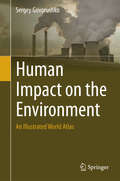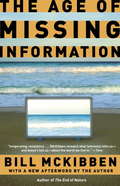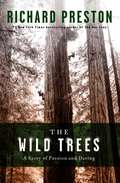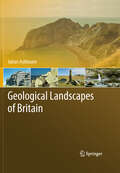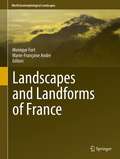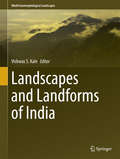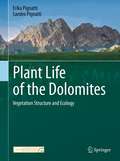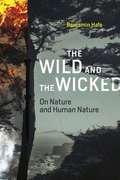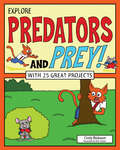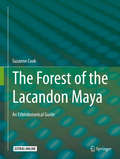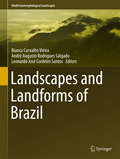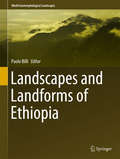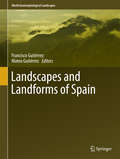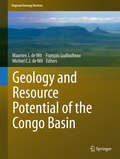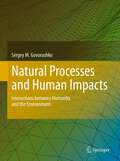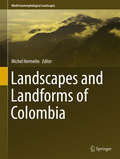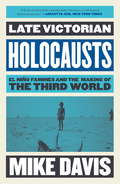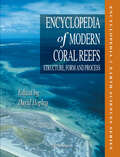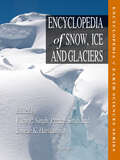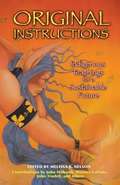- Table View
- List View
Human Impact on the Environment
by Sergey GovorushkoThis atlas presents a collection of geographical maps showing human impact on the environment. A wide variety of human impacts are discussed, ranging from the energy, mining, transport and agricultural industries as well as less visible impacts such as those of space exploration. This book is a highly illustrated atlas with 300 photos from 70 countries. Each map is accompanied by a short description of each human impact and its effect on the specific natural environment.
The Age of Missing Information
by Bill Mckibben"Highly personal and original . . . McKibben goes beyond Marshall McLuhan's theory that the medium is the message."----The New York Times Imagine watching an entire day's worth of television on every single channel. Acclaimed environmental writer and culture critic Bill McKibben subjected himself to this sensory overload in an experiment to verify whether we are truly better informed than previous generations. Bombarded with newscasts and fluff pieces, game shows and talk shows, ads and infomercials, televangelist pleas and Brady Bunch episodes, McKibben processed twenty-four hours of programming on all ninety-three Fairfax, Virginia, cable stations. Then, as a counterpoint, he spent a day atop a quiet and remote mountain in the Adirondacks, exploring the unmediated man and making small yet vital discoveries about himself and the world around him. As relevant now as it was when originally written in 1992-and with new material from the author on the impact of the Internet age-this witty and astute book is certain to change the way you look at television and perceive media as a whole."By turns humorous, wise, and troubling . . . a penetrating critique of technological society."-Cleveland Plain Dealer"Masterful . . . a unique, bizarre portrait of our life and times."-Los Angeles Times"Do yourself a favor: Put down the remote and pick up this book."-Houston Chronicle
The Wild Trees: A Story of Passion and Daring
by Richard PrestonHidden away in foggy, uncharted rain forest valleys in Northern California are the largest and tallest organisms the world has ever sustained-the coast redwood trees, Sequoia sempervirens. Ninety-six percent of the ancient redwood forests have been destroyed by logging, but the untouched fragments that remain are among the great wonders of nature. The biggest redwoods have trunks up to thirty feet wide and can rise more than thirty-five stories above the ground, forming cathedral-like structures in the air. Until recently, redwoods were thought to be virtually impossible to ascend, and the canopy at the tops of these majestic trees was undiscovered. In The Wild Trees, Richard Preston unfolds the spellbinding story of Steve Sillett, Marie Antoine, and the tiny group of daring botanists and amateur naturalists that found a lost world above California, a world that is dangerous, hauntingly beautiful, and unexplored. The canopy voyagers are young-just college students when they start their quest-and they share a passion for these trees, persevering in spite of sometimes crushing personal obstacles and failings. They take big risks, they ignore common wisdom (such as the notion that there's nothing left to discover in North America), and they even make love in hammocks stretched between branches three hundred feet in the air.The deep redwood canopy is a vertical Eden filled with mosses, lichens, spotted salamanders, hanging gardens of ferns, and thickets of huckleberry bushes, all growing out of massive trunk systems that have fused and formed flying buttresses, sometimes carved into blackened chambers, hollowed out by fire, called "fire caves." Thick layers of soil sitting on limbs harbor animal and plant life that is unknown to science. Humans move through the deep canopy suspended on ropes, far out of sight of the ground, knowing that the price of a small mistake can be a plunge to one's death.Preston's account of this amazing world, by turns terrifying, moving, and fascinating, is an adventure story told in novelistic detail by a master of nonfiction narrative. The author shares his protagonists' passion for tall trees, and he mastered the techniques of tall-tree climbing to tell the story in The Wild Trees-the story of the fate of the world's most splendid forests and of the imperiled biosphere itself.From the Hardcover edition.
Geological Landscapes of Britain
by Julian AshbournThis book discusses the geological history of Britain from the early geological formation of the British Isles, through to the variety of currently visible rock formations and ensuing natural landscapes. It is presented as an accessible narrative which may be utilised in a variety of educational contexts, or simply enjoyed as an holistic overview of the subject. It additionally provides an important visual record of British geology in the 21st century via a portfolio of high quality, scientifically accurate photographs, which are themselves part of a larger collection, being developed to become the definitive image library for British geoscience. In addition, the book provides an insight into the relationship between the geology of Britain and how early settlers interacted with the landscape throughout Mesolithic and Neolithic times. It is a book which serves equally as a scientific reference, an introduction to the subject of British geology and, no doubt, as an edition which will remain a pleasure to own in its own right.
Landscapes and Landforms of France
by Marie-Françoise André Monique FortThe Landforms and Landscapes of France provides an informative and attractive overview of the most scenic landscapes of France. The geodiversity of France is emphasized, for example the glacial landscapes of the Mont-Blanc Massif, the volcanoes of the French Massif Central, the chalk cliffs and sand dunes of the Atlantic coast, the granitic landscapes of Corsica or the lagoons and coral reefs of French Polynesia. The objectives are to provide the reader with an enjoyable and informative description of the selected sites within their regional geographical and geological settings; to offer an up-to-date survey of the evolution of France's landscape; and to give additional information on the cultural value of the selected sites wherever appropriate (prehistoric paintings, legends related to sites, famous vineyards, etc.). The book is a richly illustrated reference work that makes accessible for the first time a wealth of information currently scattered among many national and regional journals. It will be of benefit to earth scientists, environmental scientists, tourism geographers and conservationists
Landscapes and Landforms of India
by Vishwas S. KaleThe proposed monograph on 'Geomorphological Landscapes of India' will aim to describe and explain in simple words the geomorphological characteristics and the origin of the above-mentioned landforms and landscapes. The proposed monograph will provide the background information about the geology, climate and tectonic framework of the Indian region, as well as cover Indian climates of the present and the past. It will mainly cover the four main morphotectonic regions of India and about 15-20 distinct landforms of the Indian region as well as the major geomorphosites in India.
Plant Life of the Dolomites
by Sandro Pignatti Erika PignattiThis volume provides an in-depth analysis of over 100 plant communities of the Dolomite vegetation. The data is based on the phytosociological relevés, which have been collected by the authors in nearly 2000 surveys. The key part consists of approx. 130 association tables presenting plant sociological data for the respective plant communities. Thus, this volume perfectly complements the successful main volume "Plant Life of the Dolomites: Vegetation Structure and Ecology," which features summarized, synoptic association tables of the twelve habitats. In addition, geo-referenced locations of relevés and detailed ecological measures are provided. A further part describes the individual components of the fascinating dolomitic landscape (Heritage of all Humanity) and presents tables of vegetation complexes, which summarize the more than 400 surveys carried out in the Dolomites. The structure of this supplementary volume corresponds to that of the main volume with a key part consisting of twelve chapters, each describing a specific habitat, and a total of 106 associations. Several topics covered in the main volume, such as the exploration of the flora, ecological factors and syntaxonomy are discussed further here.
The Wild and the Wicked: On Nature and Human Nature
by Benjamin HaleMost of us think that in order to be environmentalists, we have to love nature. Essentially, we should be tree huggers -- embracing majestic redwoods, mighty oaks, graceful birches, etc. We ought to eat granola, drive hybrids, cook tofu, and write our appointments in Sierra Club calendars. Nature's splendor, in other words, justifies our protection of it. But, asks Benjamin Hale in this provocative book, what about tsunamis, earthquakes, cancer, bird flu, killer asteroids? They are nature, too.For years, environmentalists have insisted that nature is fundamentally good. In The Wild and the Wicked, Benjamin Hale adopts the opposite position -- that much of the time nature can be bad -- in order to show that even if nature is cruel, we still need to be environmentally conscientious. Hale argues that environmentalists needn't feel compelled to defend the value of nature, or even to adopt the attitudes of tree-hugging nature lovers. We can acknowledge nature's indifference and periodic hostility. Deftly weaving anecdote and philosophy, he shows that we don't need to love nature to be green. What really ought to be driving our environmentalism is our humanity, not nature's value.Hale argues that our unique burden as human beings is that we can act for reasons, good or bad. He claims that we should be environmentalists because environmentalism is right, because we humans have the capacity to be better than nature. As humans, we fail to live up to our moral potential if we act as brutally as nature. Hale argues that despite nature's indifference to the plight of humanity, humanity cannot be indifferent to the plight of nature.
Explore Predators and Prey!: With 25 Great Projects
by Cindy Blobaum Matt AucoinHunting, hiding, trapping, and tricking are just a few of the strategies used by animals in the wild to ensure they eat enough without being eaten themselves! In Explore Predators and Prey! With 25 Great Projects, readers ages 7 through 10 explore the physical and behavioral adaptations of predators and prey and their impact on the environment.Predators, such as hawks and foxes, have keen eyesight and sharp beaks and teeth to help them catch their prey. Prey, such as mice and rabbits, have large ears to hear danger and can move quickly to escape their enemies. Animal populations are closely integrated with each other and the surrounding environment. A change to one population causes changes to all others. Readers discover how repercussions can affect nature, including humans, and are encouraged to consider their own actions with an eye toward the effect on the environment.In Explore Predators and Prey, kids actively learn about body tools and behavior strategies as they test their own abilities to hunt and hide in a series of science-minded activities. Fun facts and colorful cartoons make learning entertaining and links to online primary sources and videos make the content accessible to all learners.
The Forest of the Lacandon Maya
by Suzanne CookThe Forest of the Lacandon Maya: An Ethnobotanical Guide, with active links to audio-video recordings, serves as a comprehensive guide to the botanical heritage of the northern Lacandones. Numbering fewer than 300 men, women, and children, this community is the most culturally conservative of the Mayan groups. Protected by their hostile environment, over many centuries they maintain autonomy from the outside forces of church and state, while they continue to draw on the forest for spiritual inspiration and sustenance. In The Forest of the Lacandon Maya: An Ethnobotanical Guide, linguist Suzanne Cook presents a bilingual Lacandon-English ethnobotanical guide to more than 450 plants in a tripartite organization: a botanical inventory in which main entries are headed by Lacandon names followed by common English and botanical names, and which includes plant descriptions and uses; an ethnographic inventory, which expands the descriptions given in the botanical inventory, providing the socio-historical, dietary, mythological, and spiritual significance of most plants; and chapters that discuss the relevant cultural applications of the plants in more detail provide a description of the area's geography, and give an ethnographic overview of the Lacandones. Active links throughout the text to original audio-video recordings demonstrate the use and preparation of the most significant plants.
Landscapes and Landforms of Brazil
by Bianca Carvalho Vieira André Augusto Rodrigues Salgado Leonardo José Cordeiro SantosThis book presents Brazil as a country of continental dimensions. Its territory has a large variety of rock types, geological structures and climates. The country has a large variety of landscapes, such as the humid plains of the Amazon River, the dry plateaus of the semi-arid region or the subtropical mountains of the southern region. On the coast, some plateaus and mountains, like the Serra do Mar Mountain range, formed a significant barrier front to access the hinterland of Brazil. On the other side of these coastal plateaus and mountains, there is a large collection of other plateaus, mountains, plains and depressions little altered by human interference. Thus, Brazil has a unique variety of different landscapes and extraordinary geomorphological sites. The book invites readers to learn more about the beautiful Brazilian landscapes, their complexity and vastness.
Landscapes and Landforms of Ethiopia
by Paolo BilliThis book provides a succinct but comprehensive presentation of key geomorphological locations and topics including information about geomorphological heritage and maps to visit the most important sites. Apart from often being remarkably scenic, landscapes reveal stories that often can be traced back in time tens of million years and include unique events. This is particularly true for Ethiopia where spectacular examples of different landforms are present. Its geomorphology varies from highlands, marked by high volcanoes and incised by deep river gorges, to the rift valley lakes endorheic systems and the below sea level lowlands with characteristic landscapes which are unique in the world. Landscapes and Landforms of Ethiopia highlights all these topics including essential information about geology and tectonic framework, past and present climate, hydrology, geographical regions and long-term geomorphological history. It is a highly informative book, providing insight for readers with an interest in geography and geomorphology.
Landscapes and Landforms of Spain
by Francisco Gutiérrez Mateo GutiérrezThe Landscapes and Landforms of Spain provides an informative and inviting overview of the geology and geomorphology of Spain. It incorporates a diverse range of topics, ranging from the fiery landscapes of the Canary Islands and its volcanic formations to the glacial scenery of the Pyrenees. The book devotes attention to granite landforms, karst terrains, coastal dunes and marshes, as well as to heritage and conservation, with the objective of offering the reader a comprehensive insight into the Spanish geological setting. The book presents readers with the opportunity to explore Spanish landforms in detail through its highly illustrated pages and maps, making this an appealing text on the subject field.
Cambridge Classical Studies: Reviving Roman Religion
by Ailsa HuntSacred trees are easy to dismiss as a simplistic, weird phenomenon, but this book argues that in fact they prompted sophisticated theological thinking in the Roman world. Challenging major aspects of current scholarly constructions of Roman religion, Ailsa Hunt rethinks what sacrality means in Roman culture, proposing an organic model which defies the current legalistic approach. She approaches Roman religion as a 'thinking' religion (in contrast to the ingrained idea of Roman religion as orthopraxy) and warns against writing the environment out of our understanding of Roman religion, as has happened to date. In addition, the individual trees showcased in this book have much to tell us which enriches and thickens our portraits of Roman religion, be it about the subtleties of engaging in imperial cult, the meaning of numen, the interpretation of portents, or the way statues of the Divine communicate.
Geology and Resource Potential of the Congo Basin
by Maarten J. de Wit François Guillocheau Michiel C. J. de WitThis book summarizes the geomorphology, geology, geochronology, geophysics and mineral resources of the Congo Basin, one of the world's most enigmatic and poorly understood major intra-continental sedimentary basins, and its flanking areas of Central Africa. It provides an up to date analysis of the large region's origin and evolution. The book's nineteen chapters take the reader through the entire basement history, as well as the Basin's ca. 700 million years of cover sequences. Starting from its Archean cratons and Proterozoic mobile belts, and proceeding through the Phanerozoic sequences, including the most recent Cenozoic successions, the book also explores the present drainage systems and the subtle but complex topography of the Congo Basin. It also presents and evaluates new basin models and related dynamic processes, as well as revised correlation schemes with its Gondwana counterparts in South America, all of which provide key insights into its rich diamond deposits and other mineral wealth, which are documented in the final chapters. A specific feature of this book is its synthesis, performed by teams of active experts, of a vast amount of geoscientific data previously only recorded in research reports, company reports, survey bulletins, and scattered journal articles and books. The sheer size of the Congo Basin (ca. 1. 8 million km2, or just under half the area of the EU) and Central Africa (some 7 million km2, or more than 70% of the area of the USA) will make this a sought-after source of information and inspiration on this unique region.
Natural Processes and Human Impacts
by Sergey M. GovorushkoThis highly topical book comes at a time when the two-way relationship between humankind and the environment is moving inexorably to the top of the agenda. It covers both sides of this delicate balancing act, explaining how various natural processes influence humanity, including its economic activities and engineering structures, while also illuminating the ways in which human activity puts pressure on the natural environment. Chapters analyze a varied selection of phenomena that directly affect people's lives, from geological processes such as earthquakes and tsunamis to cosmic events such as magnetic storms. The author moves on to consider the effect we have on nature, ranging from the impact of heavy industry to the environmental consequences of sport and recreational pastimes. Complete with maps, photographs and detailed case studies, this book provides a comprehensive overview of the biggest issue we face as a species--the way we relate to the natural world around us. This book includes more than 100 maps showing the global distribution of different natural processes/human activities and more that 450 photographs from many countries and all oceans. It will provide a valuable resource for both graduate students and researchers in many fields of knowledge. Sergey Govorushko is a chief research scholar at the Pacific Geographical Institute, Russian Academy of Sciences. He is also Professor at the Far Eastern Federal University (Vladivostok). Sergey Govorushko received his PhD from the Institute of Geography, Russian Academy of Sciences. His research activities focus on the interaction between humanity and the environment, including the impact of nature on humanity; the impact of humanity on the environment; and assessment of the interaction (environmental impact assessment, environmental audit, etc.). He has authored eight and co-authored seven monographs.
Landscapes and Landforms of Colombia
by Michel HermelinThis book provides an attractive and informative overview of Colombian landscapes and their geological evolution, including comprehensive descriptions of seventeen key selected sites in the country. It provides insight into the geomorphological diversity of Colombian landscapes characterized by climatic and topographic variation. The book covers the essence of the landscapes in the country: coastal features, mud volcanoes, desertic geoforms, snow covered peaks, active volcanoes, deeply incised canyons and subdesertic valleys. It contributes knowledge and understanding into Colombian landscapes and prospects.
Late Victorian Holocausts
by Mike DavisExamining a series of El Niño-induced droughts and the famines that they spawned round the globe in the last third of the 19th century, Mike Davis discloses the intimate, baleful relationship between imperial arrogance and natural incident that combined to produce some of the worst tragedies in human history.<P> Late Victorian Holocausts focuses on three zones of drought and subsequent famine: India, Northern China, and Northeastern Brazil. All were affected by the same global climatic factors that caused massive crop failures, and all experienced brutal famines that decimated local populations. But the effects of drought were magnified in each case because of singularly destructive policies promulgated by different ruling elites.<P> Davis argues that the seeds of underdevelopment in what later became known as the Third World were sown in this era of High Imperialism, as the price for capitalist modernization was paid in the currency of millions of peasants' lives.
Encyclopedia of Modern Coral Reefs
by Colin Woodroffe David Hopley Eberhard Gischler Guy Cabioch † I. G. Macintyre Peter Davies Rachel Wood Terry DoneCoral reefs are the largest landforms built by plants and animals. Their study therefore incorporates a wide range of disciplines. This encyclopedia approaches coral reefs from an earth science perspective, concentrating especially on modern reefs. Currently coral reefs are under high stress, most prominently from climate change with changes to water temperature, sea level and ocean acidification particularly damaging. Modern reefs have evolved through the massive environmental changes of the Quaternary with long periods of exposure during glacially lowered sea level periods and short periods of interglacial growth. The entries in this encyclopedia condense the large amount of work carried out since Charles Darwin first attempted to understand reef evolution. Leading authorities from many countries have contributed to the entries covering areas of geology, geography and ecology, providing comprehensive access to the most up-to-date research on the structure, form and processes operating on Quaternary coral reefs.
Encyclopedia of Snow, Ice and Glaciers
by Helgi Björnsson Johannes Oerlemans John F. Shroder Martyn Tranter Michael P. Bishop Pratap Singh Umesh K. Haritashya Vijay P. Singh Wilfried HaeberliThe earth's cryosphere, which includes snow, glaciers, ice caps, ice sheets, ice shelves, sea ice, river and lake ice, and permafrost, contains about 75% of the earth's fresh water. It exists at almost all latitudes, from the tropics to the poles, and plays a vital role in controlling the global climate system. It also provides direct visible evidence of the effect of climate change, and, therefore, requires proper understanding of its complex dynamics. This encyclopedia mainly focuses on the various aspects of snow, ice and glaciers, but also covers other cryospheric branches, and provides up-to-date information and basic concepts on relevant topics. It includes alphabetically arranged and professionally written, comprehensive and authoritative academic articles by well-known international experts in individual fields. The encyclopedia contains a broad spectrum of topics, ranging from the atmospheric processes responsible for snow formation; transformation of snow to ice and changes in their properties; classification of ice and glaciers and their worldwide distribution; glaciation and ice ages; glacier dynamics; glacier surface and subsurface characteristics; geomorphic processes and landscape formation; hydrology and sedimentary systems; permafrost degradation; hazards caused by cryospheric changes; and trends of glacier retreat on the global scale along with the impact of climate change. This book can serve as a source of reference at the undergraduate and graduate level and help to better understand snow, ice and glaciers. It will also be an indispensable tool containing specialized literature for geologists, geographers, climatologists, hydrologists, and water resources engineers; as well as for those who are engaged in the practice of agricultural and civil engineering, earth sciences, environmental sciences and engineering, ecosystem management, and other relevant subjects.
Original Instructions: Indigenous Teachings For A Sustainable Future
by Melissa K. NelsonIndigenous leaders and other visionaries suggest solutions to today’s global crisis • Original Instructions are ancient ways of living from the heart of humanity within the heart of nature • Explores the convergence of indigenous and contemporary science and the re-indigenization of the world’s peoples • Includes authoritative indigenous voices, including John Mohawk and Winona LaDuke For millennia the world’s indigenous peoples have acted as guardians of the web of life for the next seven generations. They’ve successfully managed complex reciprocal relationships between biological and cultural diversity. Awareness of indigenous knowledge is reemerging at the eleventh hour to help avert global ecological and social collapse. Indigenous cultural wisdom shows us how to live in peace--with the earth and one another. Original Instructions evokes the rich indigenous storytelling tradition in this collection of presentations gathered from the annual Bioneers conference. It depicts how the world’s native leaders and scholars are safeguarding the original instructions, reminding us about gratitude, kinship, and a reverence for community and creation. Included are more than 20 contemporary indigenous leaders--such as Chief Oren Lyons, John Mohawk, Winona LaDuke, and John Trudell. These beautiful, wise voices remind us where hope lies.
